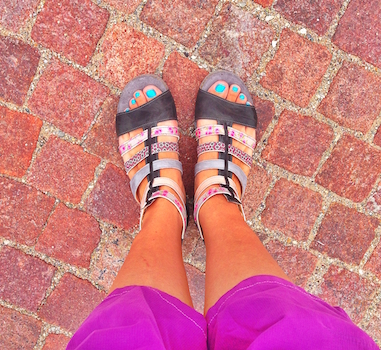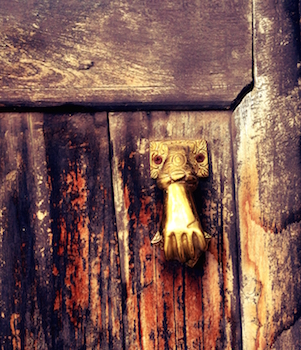Taos is as good a place as any to get into trouble. It’s late July, and I’m window-shopping with my friend Ann in the historic downtown square. We both look radiant after spending two days soaking in mineral pools an hour west of town. Why not make a quick jaunt to the historic area? we both think. Swanky boutiques, art galleries, and western-themed gift shops line each side of the square. “Look at that sculpture!” Ann points to a face made out of needles. “Artists must have a lot of free time here,” I chuckle. The spa weekend ties in perfectly with our creative writing residency in Santa Fe. The weekend is a celebration gift from Ann to me for graduating with my MFA in two weeks. The spa should be enough of a fête. We stroll the square, and I want more.
Taos is known for its light. On this day, the light is subdued by a gray hue coloring downtown. We walk once around, declining to enter shops selling Native American kitsch. Instead, we’re drawn to Our Lady of Guadalupe kitsch. Still, $40 for glitter-festooned bottle cap earrings seems overpriced.
 Photograph by Joanna ES CampbellWe find a side street off the square and walk past several shops. “Look, Ann!” A window display stops me in my tracks. The most beautiful shoes peer at me through the glass, and I am transfixed. The shoes are actually sandals with seven straps spaced evenly up the foot and ankle. Each strap is a different color, and two have patterns: one a lovely cherry blossom, the other a gray and pink geometric pattern. I have never seen shoes like these before. Ann agrees they are unique, and she may even assume I have come to New Mexico with mad money set aside. I have not.
Photograph by Joanna ES CampbellWe find a side street off the square and walk past several shops. “Look, Ann!” A window display stops me in my tracks. The most beautiful shoes peer at me through the glass, and I am transfixed. The shoes are actually sandals with seven straps spaced evenly up the foot and ankle. Each strap is a different color, and two have patterns: one a lovely cherry blossom, the other a gray and pink geometric pattern. I have never seen shoes like these before. Ann agrees they are unique, and she may even assume I have come to New Mexico with mad money set aside. I have not.
The clerk slips the shoes on my feet and folds each strap carefully, explaining the importance of proper tension. He talks about the shoes as if he is handling a rare orchid. I remember a Buddhist friend once advising me to walk as if each step pulls a lotus blossom from the ground. I feel washed in a strange desire and hand the clerk my credit card, the one with a billing statement my husband never sees. Ann cheers me on. We women are good at this when we want to do something special for ourselves. The card is declined. I try not to appear anxious. Perspiration penetrates my deodorant. “Gosh,” I say. The clerk is affable, as if credit card denial is a minor hiccup. Without hesitation, I hand the clerk my debit card, the one dependent solely upon my husband’s income as a three-quarter-time priest. “Approved,” the clerk happily exclaims.
After Ann and I arrive in Santa Fe and check in to the residency, I call my husband to tell him about the shoes. While he is surprised and concerned, he does not yell or judge. That’s not in his nature. The following day, with time to kill before a fiction reading, I feel a thud inside my body as I walk down a gallery-lined street. The handcrafted art and jewelry wink at me as I pass the gallery windows. I am stunned by an inescapable fact: my secret weapon is deactivated, and I am hungry. The lovely objects are just out of reach. I have enough sense not to empty our checking account. Instead, I seek the nearest seating option, a metal cube in a sculpture park surrounded by poplar trees. I call my husband. I think I have a problem with secret spending. Maybe I should go to therapy.
This is my clarity moment. “I thought I dodged a bullet because I don’t have my mom’s addiction.”
Free of alcoholism, the possibility of a different vice never occurred to me. My drug of choice was buying things I could not afford. Aside from a few panicked occasions about how I would get myself out of debt, I had never been confronted with the truth I might have a problem. “I now realize,” I said, “that lucky windfalls resolved those incidents in the past.”
Dennis listens. He agrees therapy could be helpful. I push the phone hard against my ear as I watch poplar branches tremble in a breeze. “It’s not surprising you do this,” he says, “You were raised in a family where the fun activity was to shop, and your parents could afford nice things. You’re practicing the same pattern except we don’t have a physician’s income to support it.”
“It goes deeper,” I respond. “When I visit a place that’s full of art, I’m compelled to spend in order to enhance the moment — like if I can’t take a piece of it home, then the experience is less real, and that’s scary.” I begin sobbing.
I hadn’t realized that a love of art and beauty could be a liability. I was good at art and beauty.
Was it that day I skipped in high school when my European History class covered Versailles? Was it my childhood? My culture? Am I just a rebel?
For too long, I have loved myself with shopping beyond my means, and the wake of spending leaves me ripped off. Months later, I will learn the phrase God-shaped hole.
I sit on the metal cube and let the truth spill. Memories from my past take a different shape — the time I returned from China feeling heartbroken, so I bought a handcrafted teapot at an art gallery . . . the day my uncle died, and I bought a new wardrobe . . . the month Dennis was on life support, and how impulses for material possessions vanished for a year. When my appetite returned, I welcomed it like an old friend, a friend I visited privately in shops and online.
“My mom’s alcoholism would be an easy answer,” I say. Maybe my family disease formed the pattern of giving myself the love I needed, but my awareness has grown in the last few years for how addiction and recovery shaped me, and a more complex truth emerges. “I think my problem is rooted in more than her struggle. I feel incomplete and search for a material fix to make me whole.”
My body begins to ache. I shift from the metal cube to the ground and run my fingers through the grass. “Dennis?”
“Yeah, honey.”
“I don’t think I know how to pray.” I picture my home and see a debris field of misguided prayers. “None of my beautiful things bring me closer to God.”
“You pray all the time. You prayed when I was in the hospital.”
When Dennis was on life support, materialistic desire slipped off me like a layer of burned skin. Artisanal possessions could not fix him or serve me. Beneath the strata of coping mechanisms was prayer, longing to be heard. For five weeks, I knit, wrote, sang, and meditated. I read poetry aloud, hung scrawled prayers, and followed the Daily Office with my mother’s help. There is no doubt Dennis recovered by medicine and prayer, and I emerged shaking. I had run a prayer marathon with little training, not realizing my spiritual foundation was made of pumice. Fear drove me back into the arms of secret spending. Surely, beautiful objects would fill in the holes and smooth the cracks.
 Photograph by Joanna ES CampbellI bought beautiful things to have a good time the way people drink to have a good time. I bought interesting objects when I felt vulnerable and used defenses like I deserve this or This is a celebration. My credit card allowed me to believe these mantras in each sweaty moment. The God-shaped hole in my heart rejected the shoes in Taos like a bad valve.
Photograph by Joanna ES CampbellI bought beautiful things to have a good time the way people drink to have a good time. I bought interesting objects when I felt vulnerable and used defenses like I deserve this or This is a celebration. My credit card allowed me to believe these mantras in each sweaty moment. The God-shaped hole in my heart rejected the shoes in Taos like a bad valve.
“I love you,” Dennis says as we end the call.
“Thank you. Thanks for listening. I love you, though I don’t deserve you.”
“I don’t deserve you,” he says, “but the grace of God, baby, that’s all I know.”
I walk away from the gallery-lined street with renewed purpose to clear my debt and care for my spiritual health. I still hunger, so I take my smartphone from my pocket and make dozens of photographs of unusual and whimsical scenes that catch my eye. I adore these photographs because there is no shortage of the unusual and whimsical in New Mexico and because these images are an act of listening. I want to buy beauty. Instead, I create prayers by my own lens. I am doing it now with these words. Creating images and stories are my imperfect act of filling the God-shaped hole inside me. We deserve to flourish, as is.
Joanna ES Campbell grew up in Little Rock, Arkansas. She earned her M.S. in resource conservation from the University of Montana and her M.F.A. in creative writing from Seattle Pacific University. You can find her essays in Jesus, Jazz, & Buddhism, Relief Journal, and Tales from the South. She lives in Eureka Springs, Arkansas, with her husband, Rev. Canon Dr. Dennis Campbell.
















